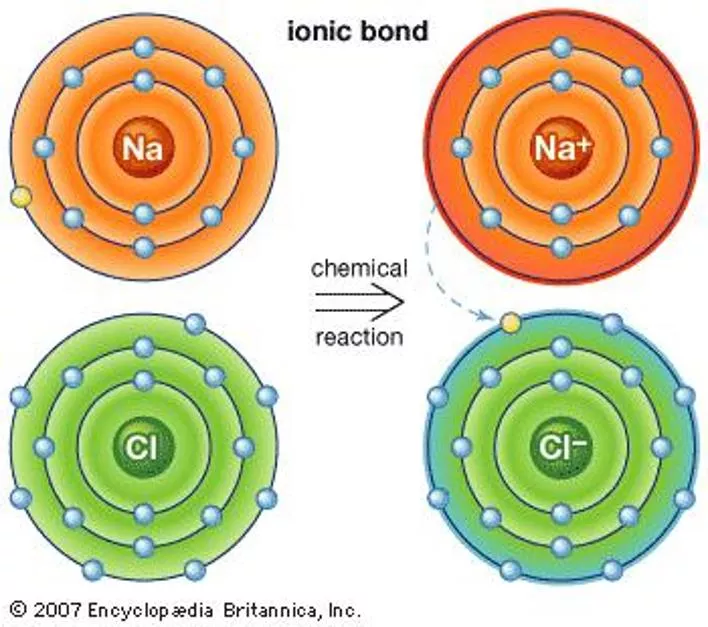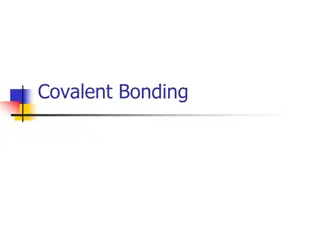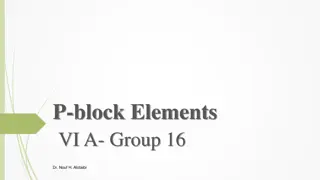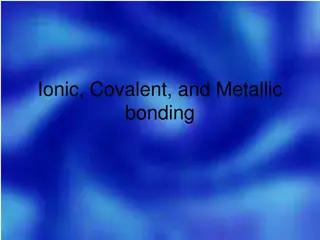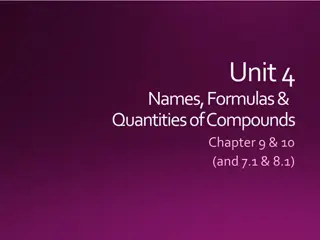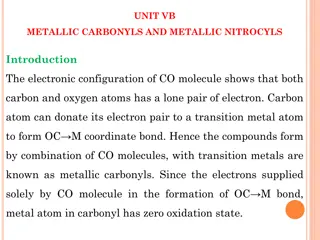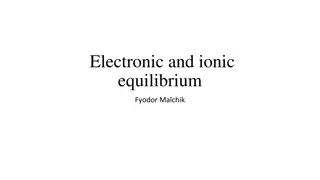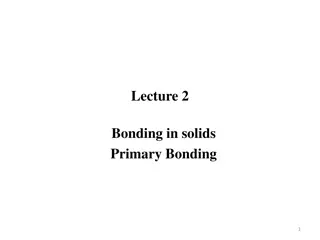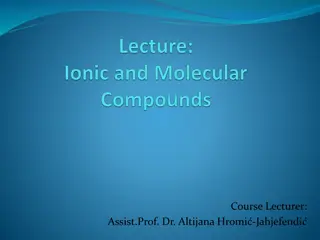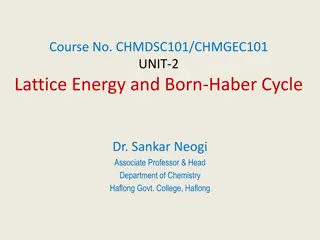Ionic and Metallic Bonding in Chemistry
Explore the concepts of ions, electron dot structures, the octet rule, cations, and anions in Chapter 7. Learn how elements achieve stability through electron configurations, and practice writing electron dot structures and naming ions. Understand the differences between cations and anions and how to determine their electron configurations and names. Dive into sample problems and practice exercises to enhance your understanding of ionic and metallic bonding.
Download Presentation

Please find below an Image/Link to download the presentation.
The content on the website is provided AS IS for your information and personal use only. It may not be sold, licensed, or shared on other websites without obtaining consent from the author.If you encounter any issues during the download, it is possible that the publisher has removed the file from their server.
You are allowed to download the files provided on this website for personal or commercial use, subject to the condition that they are used lawfully. All files are the property of their respective owners.
The content on the website is provided AS IS for your information and personal use only. It may not be sold, licensed, or shared on other websites without obtaining consent from the author.
E N D
Presentation Transcript
Chapter 7 Ionic and Metallic Bonding Jennie L. Borders
Section 7.1 - Ions Valence electrons are the electrons in the highest occupied energy level. Valence electrons are the only electrons involved in chemical bonding. Elements in the same group have the same number of valence electrons.
Electron Dot Structures Electron dot structures are diagrams that show the symbol of the element surrounded by the valence electrons as dots.
Practice Problems Write the electron dot structure for the following elements: P Ar Mg He
Octet Rule The octet rule states that atoms tend to achieve a stable configuration when they have 8 valence electrons. Metals tend to lose electrons to achieve noble-gas configuration. Nonmetals tend to gain electrons to achieve noble-gas configuration.
Cations A cation ion is a positive ion that has lost electrons. When writing the electron configuration for a cation, write the electron configuration for the atom and then subtract the electrons from the highest energy level. When you name a cation, the name of the element does not change. Ex: Ca+2= calcium ion
Sample Problem Write the electron configuration and name for the following: Sr2+ 1s22s22p63s23p63d104s24p6 Strontium ion Fe+3 1s22s22p63s23d5 Iron ion
Practice Problems Write the electron configurations and the name for the following: Zn+2 1s22s22p63s23p63d10 Zinc ion Na+ 1s22s22p6 Sodium ion
Anions Anions are negatively charged ions that have gained electrons. When writing the electron configuration for anions, write the electron configuration for the atom and then add the correct number of electrons. When naming an anion, you change the ending of the element to ide. Ex: Cl- = chloride ion
Sample Problems Write the electron configuration and name for the following: P-3 1s22s22p63s23p6 Phosphide ion F- 1s22s22p6 Fluoride ion
Practice Problems Write the electron configuration and name for the following: Br- 1s22s22p63s23p63d104s24p6 Bromide ion S-2 1s22s22p63s23p6 Sulfide ion
Section 7.1 Assessment 1. How can you determine the number of valence electrons in an atom of a representative element? 2. Atoms of which elements tend to gain electrons? Atoms of which elements tend to lose electrons? 3. How do cations form? 4. How do anions form? 5. How many valence electrons are in each atom? a. Potassium b. Carbon c. Magnesium d. Oxygen 6. Draw the electron dot structure for each element in question 5.
Section 7.1 Assessment 7. How many electrons will each element gain or lose in forming an ion? a. calcium b. fluorine c. aluminum d. oxygen 8. Write the name and symbol of the ion formed when a. a potassium atom loses one electron. b. a zinc atom loses two electrons. c. a fluorine atom gains one electron. 9. Write the electron configuration of Cd+2.
Section 7.2 Ionic Bonds and Ionic Compounds Compounds composed of cations and anions are called ionic compounds. Although they are composed of ions, ionic compounds are electrically neutral. The electrostatic forces that hold ions together are called ionic bonds.
Formulas A chemical formula shows the kinds and numbers of atoms in the smallest representative unit of a substance. A formula unit is the lowest whole-number ratio of ions in an ionic compound.
Balancing Charges When you balance charges to write the formula for an ionic compound, you must make the + charge and charge equal by adding subscripts. The subscripts must be in the lowest ratio to be correct.
Sample Problems Write the formula for the compound formed between the following elements. Potassium and oxygen K2O Magnesium and nitrogen Mg3N2
Practice Problems Write the formula for the compound when the following elements combine. Potassium and iodine KI Aluminum and oxygen Al2O3 Calcium and chlorine CaCl2 Barium and sulfur BaS
Polyatomic Ions Polyatomic ions are a group of atoms with an overall charge. When balancing charges for polyatomic ions, you follow the same rule of cancelling the + and charge. However, if you need to add a subscript to a polyatomic ion, then you have to put the polyatomic ion in parentheses. Ex: Ca(NO3)2
Sample Problems Write the formula for the compound when the following ions combine: Sodium and phosphate Na3PO4 Ammonium nitride (NH4)3N Aluminum carbonate Al2(CO3)3
Practice Problems Write the formula for the compound when the following ions combine: Barium nitrate Ba(NO3)2 Lithium phosphate Li3PO4 Strontium sulfite SrSO3
Properties of Ionic Compounds Properties of ionic compounds include the following: Crystalline solids High melting points Conduct electricity when molten or aqueous Made of metals and nonmetals Made of cations and anions Made of ionic bonds
Crystals A crystal is a substance with a 3-D repeating arrangement of particles called the crystal lattice. The coordination number of an ion is the number ions of opposite charge that surround the ion in a crystal. SKIP
Section 7.2 Assessment 1. How can you describe the electrical charge of an ionic compound? 2. What properties characterize ionic compounds? 3. Write the correct chemical formula for the compounds formed by each pair of ions. a. K+, S-2 b. Ca+2, O-2 c. Na+, O-2 d. Al+3, N-3
Section 7.2 Assessment 4. Write formulas for each compound. a. barium chloride b. Magnesium oxide c. Lithium oxide d. Calcium fluoride 5. Which pairs of elements are likely to form ionic compounds? a. Cl, Br b. Li, Cl c. K, He d. I, Na
Section 7.3 Bonding in Metals The valence electrons of metal atoms can be modeled as a sea of electrons. Metallic bonds consist of the attraction of the free- floating valence electrons for the positively charged metal ions. Metals are good conductors and malleable because of their mobile electrons.
Metals Metals are the most simple crystals because they contain one type of element.
Alloys An alloy is a mixture with metallic properties. A substitutional alloy is made when atoms of one metal replace atoms of another metal. An interstitial alloy is made when smaller metal atoms are inserted in between larger metal atoms.
Section 7.3 Assessment 1. How do chemists model the valence electrons in metal atoms? 2. How can you describe the arrangement of atoms in metals? 3. Why are alloys more useful than pure metals? 4. Describe what is meant by ductile and malleable.
Section 9.1 Naming with Regular Metals A monatomic ion is a single atom with a charge. Ex: Na+ or O-2 When naming a cation, the name of the element does not change. Ex: K+ = potassium When naming an anion, the ending of the element changes to ide. Ex: O-2 = oxide
Polyatomic Ions A polyatomic ion is a group of atoms with an overall charge. Ex: SO4-2 Most polyatomic ions end in ate or ite. The ending does not change when naming a compound (unless it is an acid which we will talk about later). The ate suffix indicates that the polyatomic ion contains one more oxygen than the polyatomic ion with the ite suffix. (Ex: sulfate = SO4-2, sulfite = SO3-2)
Naming with Regular Metals The regular metals are located in groups 1 and 2 (except for H). Aluminum is also a regular metal. When naming a compound that starts with a regular metal, you name the metal (cation) and add ide to the nonmetal (anion). Ex: NaCl = sodium chloride If the anion is a polyatomic ion, then you do not change the ending. Ex: CaCO3 = calcium carbonate
Sample Problems Name the following compounds: Na2O Sodium oxide AlBr3 Aluminum bromide Li2SO4 Lithium sulfate
Practice Problems Name the following compounds: LiNO3 Lithium nitrate Ca2(PO4)3 Calcium phosphate (NH4)2O Ammonium oxide
Writing the Formula with Regular Metals When writing the formula of a compound that starts with a regular metal, you must BALANCE THE CHARGES. Ex: aluminum bromide AlBr balance charges Al+3Br- AlBr3
Sample Problems Write the formula for the following compounds: Aluminum chloride AlCl3 Calcium acetate Ca(C2H3O2)2 Lithium fluoride LiF
Practice Problems Write the formula for the following compounds: Calcium carbonate CaCO3 Aluminum oxide Al2O3 Cesium oxalate Cs2C2O4
Section 9.1 Assessment 1. What are the usual ending for the names of polyatomic ions? 2. How does a polyatomic ion differ from a monatomic ion? 3. Write the formula for these binary compounds. a. Beryllium chloride b. Cesium sulfide c. Sodium iodide d. Strontium oxide
Section 9.1 Assessment 4. Write the formula for these compounds. a. sodium perchlorate b. magnesium hydrogen carbonate c. calcium acetate 5. Identify any incorrect formulas. Explain your answer. a. Mg2(SO4)3 b. Rb3As c. BeCl3 d. NaF
Section 9.2 Naming with Transition Metals Transition metals can have multiple charges, so you cannot tell the charge based on the group it is in. Since transition metals can have multiple charges, we use a roman numeral to indicate the charge. Review of Roman Numerals 1 = I 2 = II 3 = III 4 = IV 5 = V **You should not use a roman numeral over 5.
Transition Metals When naming compounds that start with a transition metal, you should balance charges to figure out the charge of the transition metal. Remember add ide to the anion if it is not a polyatomic ion. Ex: CuO we know that O has a -2 charge. CuO-2 to cancel out a -2, Cu must be +2 Cu+2O-2 so the name would be copper (II) oxide.
Sample Problems Write the names for the following: Cu2O Copper (I) oxide FeCl3 Iron (III) chloride PbSO4 Lead (II) sulfate
Practice Problems Write the name of the following: PbS2 Lead (IV) sulfide Zn(C2H3O2)2 Zinc (II) acetate Ag3PO3 Silver (I) phosphite
Old Names for Transition Metals (Honors) For the old naming system for transition metals, the old Latin names are used with the suffix ic or ous. Ion Fe3+ Fe2+ Cu2+ Cu+ Co3+ Co2+ Sn4+ Sn2+ Pb4+ Pb2+ Hg2+ Hg22+ Old Name ferric ferrous cupric cuprous cobaltic cobaltous stannic stannous plumbic plumbous mercuric mercurous
Old Names for Transition Metals (Honors) The ic ending indicates a higher charge, and the ous ending indicates a lower charge. When writing the name for a compound, you figure out the charge for the transition metal and then find the old name on the chart. Ex: FeS Fe+2S-2 Fe+2 = ferrous FeS = ferrous sulfide
Practice Problems Write the old names for the following: (***Regular: Just do regular naming system) Cu3P Honors: Cuprous phosphide Regular: copper (I) phosphide Fe(NO3)3 Honors: Ferric nitrate Regular: iron (III) nitrate PbS Honors: Plumbous sulfide Regular: lead (II) sulfide
Writing the Formulas for Transition Metals When writing the formula for a compound that starts with a transition metal, you must BALANCE THE CHARGES. Ex: vanadium (V) fluoride VF balance charges V+5F- VF5 REMEMBER THE ROMAN NUMERAL IS THE CHARGE, NOT THE SUBSCRIPT!!!!!!!!!!!!!!!!
Sample Problems Write the formula for the following: Tin (II) permanganate Sn(MnO4)2 Mercury (I) oxide Hg2O Co2(CO3)3 Honors: Cobaltic carbonate Regular: vanadium (II) hydroxide V(OH)2
Practice Problems Write the formula for the following: Gold (II) iodide AuI2 Vanadium (IV) nitrite V(NO2)4 FeCrO4 Honors: ferrous chromate Regular: silver (I) nitride Ag3N



